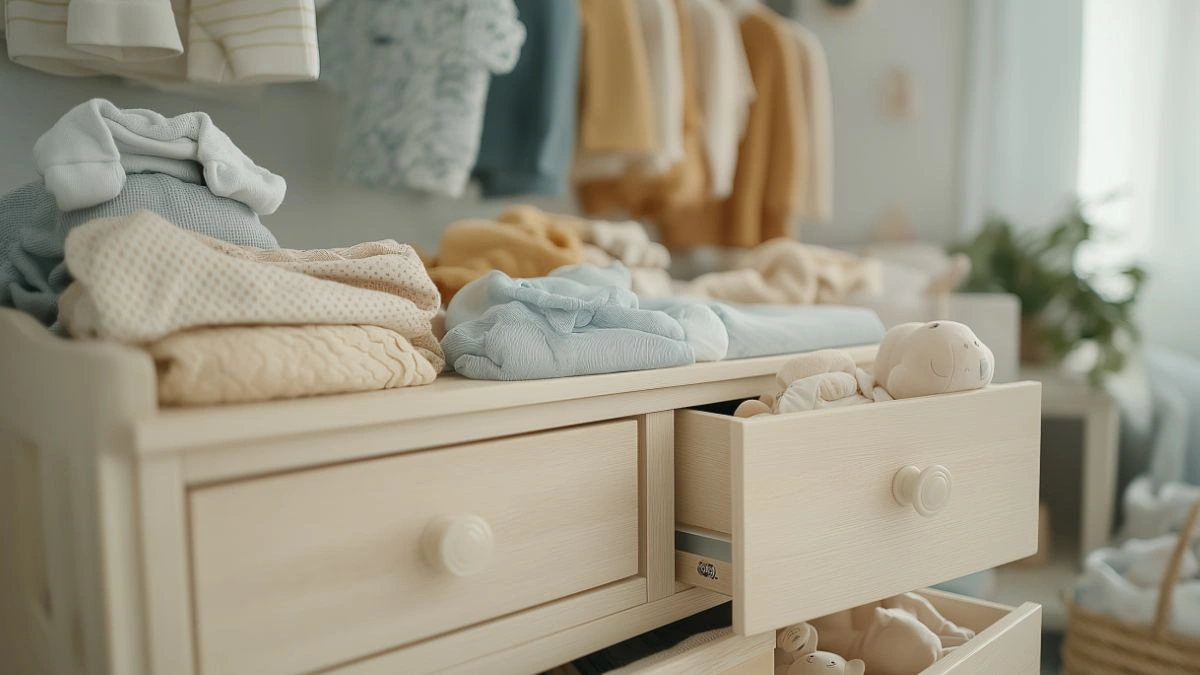Nursery Dresser Organization: Declutter and Simplify Your Baby’s Space
Table of Contents
Bringing home a new baby brings joy, love—and a lot of stuff. From onesies and burp cloths to diapers, pacifiers, and swaddles, your baby’s dresser can quickly become a cluttered catch-all. If you’ve ever fumbled through drawers at 3 AM looking for a clean sleeper, you know the importance of having a well-organized nursery dresser.
An organized dresser not only saves time and reduces stress but also promotes safety and efficiency. According to pediatric home safety guidelines, keeping items in their designated spots helps reduce hazards and allows caregivers to respond more quickly during daily routines like changing or feeding. The good news? You don’t need an expensive system to get things in order. With thoughtful planning, practical dividers, and smart categorization, even the most chaotic baby dresser can be transformed into a serene, functional space.
This post will guide you through practical strategies to organize your baby’s dresser with style and intention. We’ll cover drawer layouts, storage accessories, labeling tips, and how to keep everything tidy as your baby grows. Whether you’re prepping for a newborn or refreshing a toddler’s space, these tips will simplify your daily routines and create a calming environment.
Start with a Clean Slate: Declutter Before You Organize
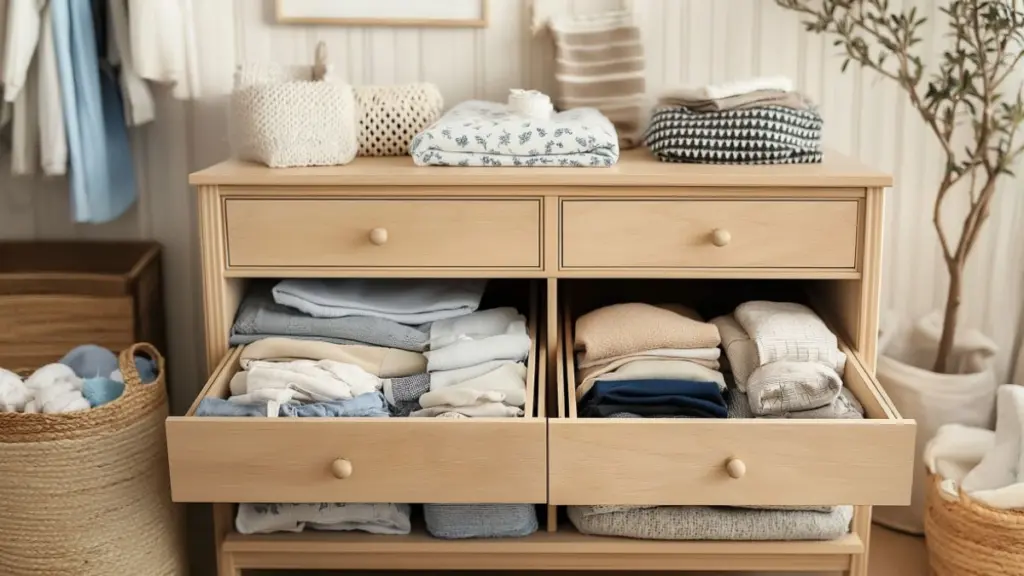
Before organizing anything, you need to take everything out and assess what you actually need. New parents often accumulate duplicate items, baby gifts in the wrong sizes, or outgrown essentials that haven’t been rotated out. Starting with a clean slate allows you to be intentional about every item you keep.
Spread everything out on a clean surface, grouping similar items together—like socks, onesies, and bibs. Then take stock of what’s usable now, what can be stored for later sizes, and what can be donated or recycled.
Decluttering Checklist for Nursery Dresser
| Item Type | Keep | Store | Donate/Recycle |
|---|---|---|---|
| Onesies | Fits now | Too big | Outgrown or unused |
| Diapers | Current size | Future sizes | Opened, unused packs |
| Washcloths | Gently used | New extras | Stained/torn ones |
| Accessories | In use | Seasonal items | Multiples or unused |
Be honest with yourself. If you’ve never reached for it, it’s probably not worth keeping. Clearing the excess makes room for a more efficient layout.
Divide and Conquer: The Power of Drawer Dividers
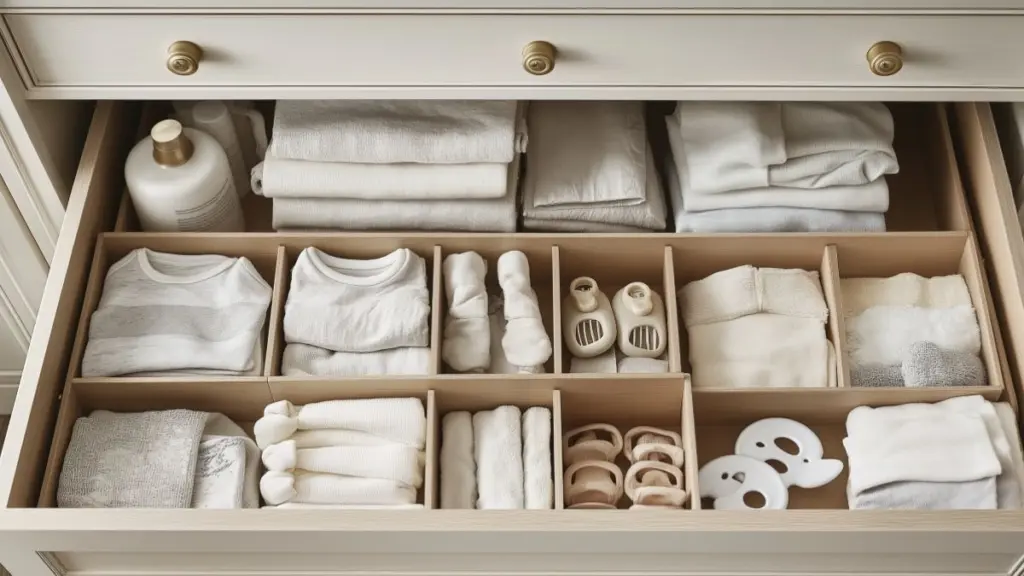
One of the most effective tools for nursery dresser organization is the humble drawer divider. Whether you buy adjustable dividers or repurpose small containers and boxes, separating drawers into sections prevents items from mixing and makes everything easier to find.
Use smaller compartments for socks, mittens, and pacifiers, and larger sections for folded onesies, sleepers, or muslin blankets. This also helps other caregivers quickly locate essentials, keeping routines smooth and stress-free.
Drawer Divider Ideas and What to Store
| Divider Type | Best For | DIY Option |
|---|---|---|
| Adjustable plastic | Onesies, sleepers | Recycled food containers |
| Felt boxes | Diapers, bibs | Cut cardboard from packaging |
| Wooden grid inserts | Socks, hats, small toys | Craft store wood kits |
| Fabric baskets | Swaddles, nursing covers | Old shoe boxes with liners |
Make sure dividers fit snugly within your drawers so they don’t slide around. Measure your drawer interiors before purchasing or repurposing containers.
Strategic Drawer Layout: What to Store Where
The layout of your dresser drawers can dramatically impact your nursery’s flow. The goal is to make the most-used items the most accessible. Think of your top drawers as your quick-grab zone, middle drawers as your core storage, and bottom drawers for backups or seasonal items.
Customize based on your routine. If your dresser also doubles as a changing table, keep diapering supplies close at hand. If it’s across the room, prioritize clothes and everyday accessories instead.
Suggested Dresser Drawer Layout
| Drawer Level | What to Store | Why It Works |
|---|---|---|
| Top Drawer | Diapers, wipes, creams, pacifiers | Most frequently accessed |
| Middle Drawer | Onesies, pajamas, bibs, burp cloths | Core clothing items |
| Bottom Drawer | Swaddles, extra sheets, future-size clothes | Less accessed, but still important |
Rotate items seasonally or as your baby grows, keeping the current size and climate in mind. Use drawer labels to keep everything clear.
Label Everything for Easy Access
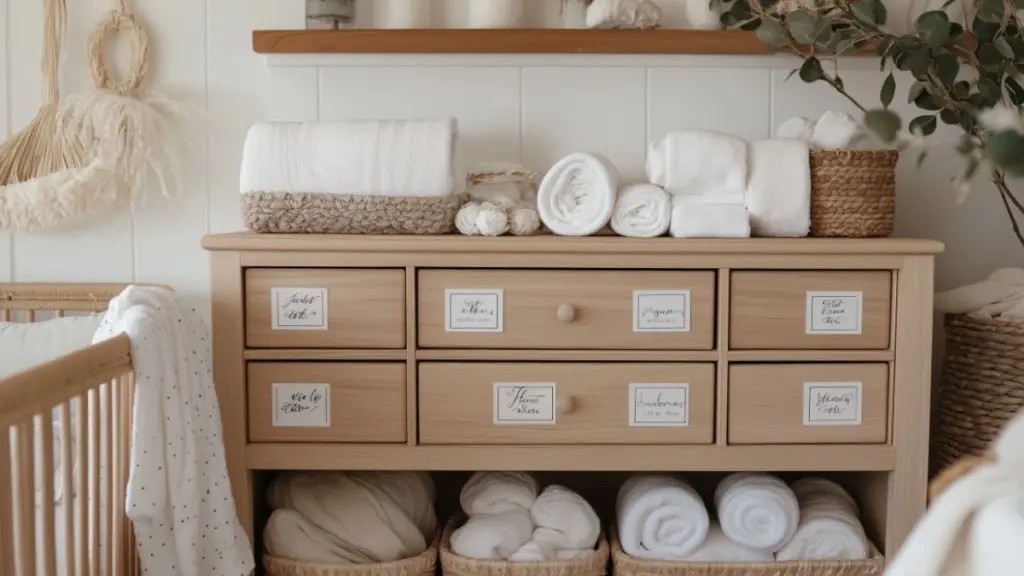
Even the most organized dresser can fall apart if other caregivers can’t find what they’re looking for. Labeling drawers—especially when using dividers—can prevent frustration and maintain order.
Use adhesive labels, hanging tags, or clip-on labels to mark each section. Labels can include item type (“Socks”), size (“3–6 Months”), or category (“Nightwear”). For a stylish touch, use wooden tags or hand-lettered cardstock that match your nursery’s aesthetic.
Types of Labels and Where to Use Them
| Label Type | Best For | Looks Best With |
|---|---|---|
| Adhesive labels | Plastic dividers or bins | Modern or minimalist nurseries |
| Clip-on tags | Fabric or wire baskets | Neutral or rustic styles |
| Chalkboard tags | Wood drawer fronts | Farmhouse or vintage themes |
| Handwritten cards | DIY setups with clear pouches | Personalized or eclectic spaces |
Labels make it easier for grandparents, babysitters, and even sleepy parents to maintain consistency.
Rotate and Restock with a Seasonal System
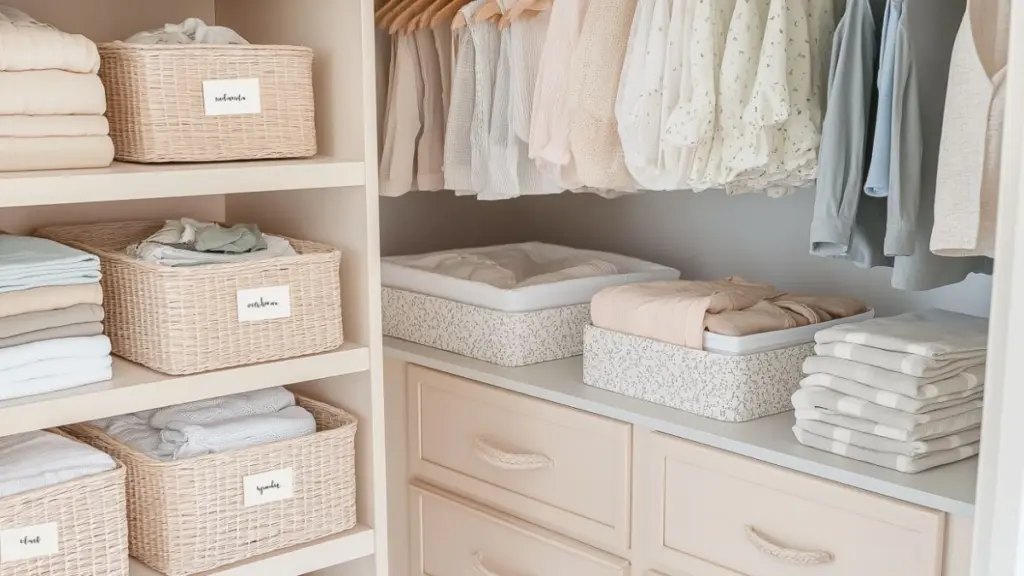
Babies grow quickly, and their needs shift just as fast. What fit last month may not work today. That’s why a rotating system can keep your nursery dresser organized without a full overhaul every few weeks.
Create a seasonal bin or storage tote where you keep clothes that are slightly too big or out-of-season. Review the bin monthly, and refresh your dresser drawers with clothes that fit your baby now. This reduces clutter and keeps your baby’s wardrobe relevant.
Monthly Dresser Maintenance Guide
| Task | When to Do It | Benefit |
|---|---|---|
| Rotate clothing sizes | Monthly or quarterly | Keeps drawers efficient |
| Check for outgrown items | When laundry is folded | Prevents unnecessary clutter |
| Replenish diaper supplies | Weekly or as needed | Maintains a smooth routine |
| Wipe down drawer interiors | Monthly | Maintains cleanliness |
Keep a donation bag nearby for clothes your baby has outgrown. This makes decluttering a seamless part of your routine.
Add a Touch of Style Without Sacrificing Function
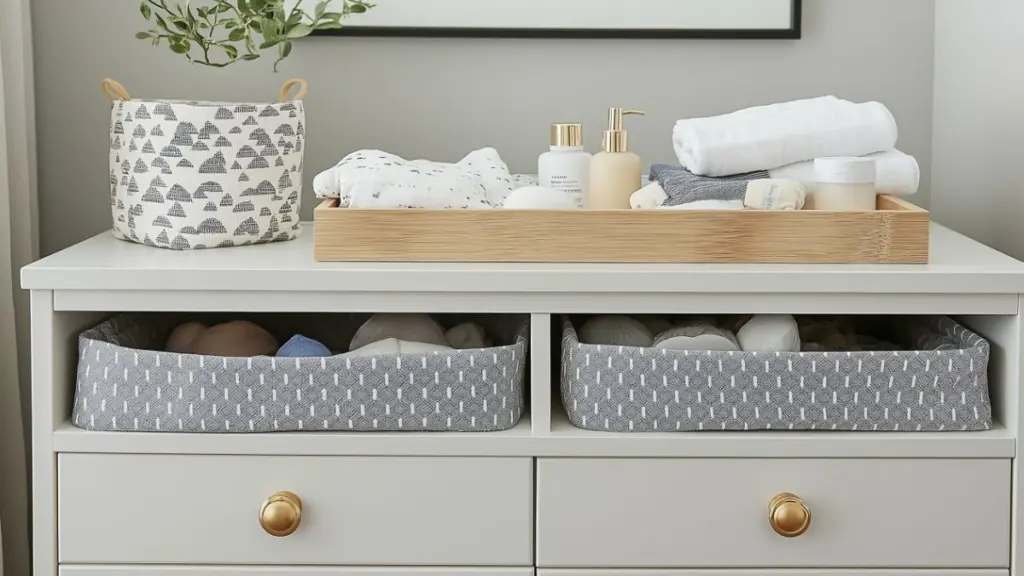
Functionality is key in nursery dresser organization, but that doesn’t mean you have to sacrifice style. In fact, a dresser that blends beauty with purpose enhances the whole nursery vibe. Think soft drawer liners, elegant knobs, and matching containers that elevate the space.
Choose a color palette that complements your nursery design—soft pastels, warm neutrals, or bold patterns. Coordinated bins and textiles give the entire dresser a cohesive look. You can even customize drawer fronts with peel-and-stick wallpaper or decals.
Ways to Style an Organized Dresser
| Element | Style Tip | Functional Benefit |
|---|---|---|
| Decorative drawer knobs | Choose shapes like stars or animals | Adds grip and personality |
| Matching fabric bins | Stick to one fabric or color family | Creates a clean, unified appearance |
| Drawer liners | Use patterns to add a pop of color | Easy to clean, protects drawers |
| Top-of-dresser decor | Use trays for lotion, wipes, or toys | Keeps surface organized and stylish |
Just remember—style should never hinder access. Every decorative touch should serve a functional role in your daily routine.
Conclusion
An organized nursery dresser isn’t just about aesthetics—it’s about creating calm in the chaos of early parenthood. With thoughtful decluttering, smart drawer layouts, and a bit of stylish flair, you can turn your baby’s dresser into a stress-free zone that simplifies your daily routine.
Whether you’re prepping for your first newborn or rethinking an overflowing toddler setup, these nursery dresser organization tips will help you stay ahead of the clutter while creating a peaceful, functional space that grows with your child.

